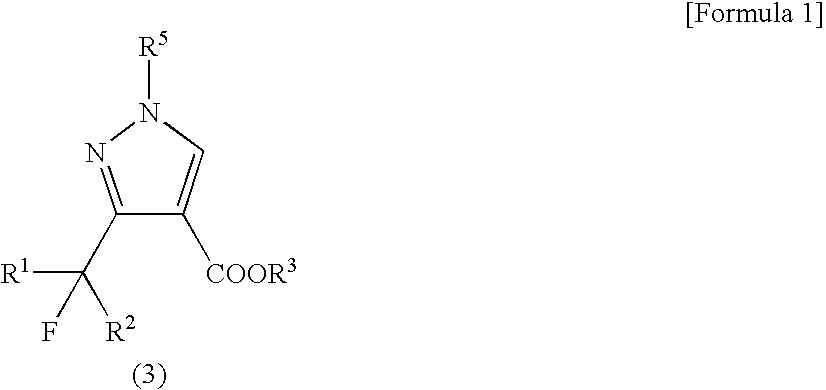Process for Producing 1-Substituted-3-Fluoroalkylpyrazole-4-Carboxylate
a technology of fluoroalkylpyrazole and carboxylate, which is applied in the field of process for producing 1substituted 3fluoroalkylpyrazole4carboxylate, can solve the problems of difficult industrialization, lack of economic efficiency of methods, and difficulty in industrialization of silica gel column chromatography, etc., and achieves high selective production, simple and safe operation, and high yield
- Summary
- Abstract
- Description
- Claims
- Application Information
AI Technical Summary
Benefits of technology
Problems solved by technology
Method used
Image
Examples
example 1
[0036]Ethyl 1-methyl-3-trifluoromethylpyrazole-4-carboxylate was produced according to the following reaction formula:
[0037]A 35% by weight aqueous solution of methylhydrazine (0.197 mL, 1.5 mmol) was added to a solution of potassium hydroxide (28 mg, 0.5 mmol) in water (5.0 mL) with stirring. To the solution, ethyl 2-ethoxymethylene-4,4,4-trifluoroacetoacetate (0.097 mL, 120 mg, 0.5 mmol) was added dropwise under ice-cooling, followed by stirring for 1 hour at ambient temperature. To the reaction mixture, 1N hydrochloric acid was added to neutralize it, and a saturated aqueous solution of sodium chloride (20 mL) was further added, followed by extraction with chloroform (20 mL×3). The organic layer was dried over anhydrous sodium sulfate, and the desiccant was separated by filtration. Then, the filtrate was evaporated to dryness under reduced pressure, thereby obtaining a white solid (90 mg, yield: 81%) composed of ethyl 1-methyl-3-trifluoromethylpyrazole-4-carboxylate and ethyl 1-m...
example 2
[0040]A35% by weight aqueous solution of methylhydrazine (0.197 mL, 2.3 mmol) was added to a solution of sodium hydroxide (20 mg, 0.5 mmol) in water (5.0 mL) with stirring. To the solution, ethyl 2-ethoxymethylene-4,4,4-trifluoroacetoacetate (0.097 mL, 120 mg, 0.5 mmol) was added dropwise under ice-cooling, followed by stirring for 1 hour at ambient temperature. To the reaction mixture, 1N hydrochloric acid was added to neutralize it, and a saturated aqueous solution of sodium chloride (20 mL) was further added, followed by extraction with chloroform (20 mL×3). The organic layer was dried over anhydrous sodium sulfate, and the desiccant was separated by filtration. Then, the filtrate was evaporated to dryness under reduced pressure, thereby obtaining a white solid (96 mg, yield: 86%) composed of ethyl 1-methyl-3-trifluoro-methylpyrazole-4-carboxylate and ethyl 1-methyl-5-trifluoro-methylpyrazole-4-carboxylate. GC analysis revealed that the ratio of the former and the latter was 98:2...
example 3
[0041]Methylhydrazine (10.6 mL, 200 mmol) was added to a solution of potassium hydroxide (4.4 g, 78.4 mmol) in water (100 mL) with stirring. To the solution, ethyl 2-ethoxy-methylene-4,4,4-trifluoroacetoacetate (16.0 g, 66.7 mmol) was added dropwise under ice-cooling, taking about 30 minutes, followed by stirring for 1 hour at ambient temperature. After the reaction was completed, a solid deposited was taken by filtration, fully washed with water, and then, dried, thereby obtaining a white solid (10.4 g, yield: 70%) composed of ethyl 1-methyl-3-trifluoromethylpyrazole-4-carboxylate and ethyl 1-methyl-5-trifluoromethylpyrazole-4-carboxylate. GC analysis revealed that the ratio of the former and the latter was 99:1.
PUM
 Login to View More
Login to View More Abstract
Description
Claims
Application Information
 Login to View More
Login to View More - R&D
- Intellectual Property
- Life Sciences
- Materials
- Tech Scout
- Unparalleled Data Quality
- Higher Quality Content
- 60% Fewer Hallucinations
Browse by: Latest US Patents, China's latest patents, Technical Efficacy Thesaurus, Application Domain, Technology Topic, Popular Technical Reports.
© 2025 PatSnap. All rights reserved.Legal|Privacy policy|Modern Slavery Act Transparency Statement|Sitemap|About US| Contact US: help@patsnap.com



